Nai Leng Consciously Experiences Death & Rebirth: Past Life Story of Nai Leng | Chaokhun Rajsuthajarn (Choate)
- CATEGORY
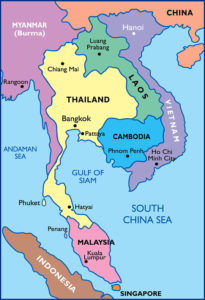 How Case Derived: Past Life Memories in Childhood
How Case Derived: Past Life Memories in Childhood
Researchers: Francis Story and Ian Stevenson, MD
From: Cases of the Reincarnation Type, Volume IV, Thailand and Burma
Article by: Walter Semkiw, MD
This case is remarkable in that Nai Leng, who was an avid practitioner of meditation, was able to consciously experience his death and rebirth into the body of an infant. If this account is valid, it gives us fascinating insight into what happens with one of the most anxiety provoking of events in life that we face, that is, our own death.
The Lives of Nai Leng and his Sister Nang Rien
Nail Leng was born in 1863 in the small village of Ban Kraton, which is near the city of Surin, in Thailand. This area is near the Cambodian border and there are pockets of Cambodians who live in the area, whose speak the Cambodian language which is called Khmer.
Nai Leng was the eldest of 7 children. His father was Wa Sawa and his mother was Ma Chama, though she was called by her nickname, Ee Mah.
Nai Leng and his Sister Witness a Birth on the Side of a Road
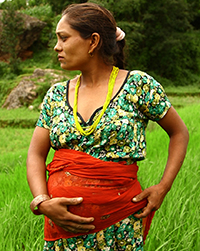 Nai Leng was very close to his sister, Nang Rien, who was a year younger than him. When he was 15 years of age, Nai Leng had an unusual experience. He and Nang Rien finished working in the fields and were walking home when they encountered a woman on the road who had just delivered a baby. The woman’s husband was attempting to bring his wife to her mother’s home for the delivery, but they didn’t make it in time. The woman was resting with her newborn child before they continued on their journey. The sight made a strong impression on Nai Leng.
Nai Leng was very close to his sister, Nang Rien, who was a year younger than him. When he was 15 years of age, Nai Leng had an unusual experience. He and Nang Rien finished working in the fields and were walking home when they encountered a woman on the road who had just delivered a baby. The woman’s husband was attempting to bring his wife to her mother’s home for the delivery, but they didn’t make it in time. The woman was resting with her newborn child before they continued on their journey. The sight made a strong impression on Nai Leng.
Nai Leng Enters a Monastary and Learns to Read Cambodian or Khmer
When he was 16 years of age, Nai Leng entered a Buddhist monastery, where they had a set of Buddhist scriptures written in Khmer. Though Nai Leng’s native language was Thai, he learned to read the scriptures written in Khmer. This was not an easy feat, as the Khmer alphabet characters are very different from Thai characters. Choate became so adept that eventually he taught other monks how to read the Khmer scriptures. In addition to studying Buddhist texts, mediation was a central activity of the monks.
Nai Leng Becomes Fluent in Laotian
When he was 25 years old, Nai Leng decided to leave the monastery to become a farmer. In addition to growing crops, Nai Leng made money by trading goods. He would travel by oxcart in this pursuit and frequently visited Laos, so much so that he became fluent in Laotian. He married and eventually had three daughters, whose names were Pa, Poh and Pi. Though he was no longer a monk, Nail Leng continued to be a devout Buddhist and meditated every night. (1)
Nang Rien becomes a Nun while Pregnant
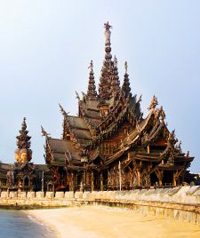 Nang Rien, Nai Leng’s younger sister, eventually married and had 3 children. When she was 45 years old, she became pregnant once again. The year was 1908. During this pregnancy, in contrast to her previous pregnancies, Nang Rien became deeply spiritual and even decided to become a Buddhist nun. She shaved her hair, put on a white robe and moved to the Wat Takien monastery, which was 9 miles or 15 kilometers from Ban Kraton, the village where Nang Rien and Nai Leng lived. (2)
Nang Rien, Nai Leng’s younger sister, eventually married and had 3 children. When she was 45 years old, she became pregnant once again. The year was 1908. During this pregnancy, in contrast to her previous pregnancies, Nang Rien became deeply spiritual and even decided to become a Buddhist nun. She shaved her hair, put on a white robe and moved to the Wat Takien monastery, which was 9 miles or 15 kilometers from Ban Kraton, the village where Nang Rien and Nai Leng lived. (2)
Nai Leng develops an Illness, Dies and Reincarnates as Choate
While Nang Rien was in the monastery, just before she returned home to delivery her baby, her brother Nai Leng developed a fever. Nang Rien traveled back to Ban Kraton during her brother’s illness and arrived home, where she delivered her child on October 12, 1908, who was named Chaokhun Rajsuthajarn, though he would be known in the family by his nickname, which was Choate. Nai Leng was ill for 6 days before he died on October 13, 1908 at the age of 45. As such, Choate was born one day before Nai Leng died. (3)
Choate was destined to become a famous monk in Thailand and towards the end of his life, he wrote an autobiography, which was published when Choate was 61 years of age in the year 1969. In this book, Choate explains that in his prior incarnation, he was Nai Leng and that he was conscious during Nai Leng’s death and rebirth as the infant Choate.
Split Incarnation, Parallel Lives, Twin Souls, Twin Flames or Cases with Anomalous Dates: Overlapping Lifetimes
 The reader may object that this is not possible, as Chaote was born a day before Nai Leng died, but this phenomenon of a soul inhabiting more than one body at a time is observed in a number of scientifically researched reincarnation cases. Ian Stevenson referred to these as cases with “anomalous dates,” referring to the overlap of lifetimes. I refer to this phenomenon as “split incarnation,” as the soul is able to split its energy into more than one body. Other terms used for this phenomenon include parallel lives, twin souls or twin flames. In this case, the soul of Nai Leng was animating both the body of Nai Leng and the body of the infant Choate at the same time for a period of about a day. To review cases of this type, go to: Split Incarnation
The reader may object that this is not possible, as Chaote was born a day before Nai Leng died, but this phenomenon of a soul inhabiting more than one body at a time is observed in a number of scientifically researched reincarnation cases. Ian Stevenson referred to these as cases with “anomalous dates,” referring to the overlap of lifetimes. I refer to this phenomenon as “split incarnation,” as the soul is able to split its energy into more than one body. Other terms used for this phenomenon include parallel lives, twin souls or twin flames. In this case, the soul of Nai Leng was animating both the body of Nai Leng and the body of the infant Choate at the same time for a period of about a day. To review cases of this type, go to: Split Incarnation
Nai Leng’s Death Experience with Remote Viewing
Let us review Choate’s own account of being aware of events during the death of Nai Leng and his rebirth as Choate. In this narrative, Chaote describes how he was able to telepathically be aware of the activites of his sister, Nang Rien, at the the temple where she was a nun, which was 9 miles away from Nai Leng’s home. This ability to witness events telepathically at a distant location is termed: Remote Viewing
Let us now go back to the time to when Nang Rien was in the 7th month of her pregnancy, at around the time she became a Buddhist nun and moved to the monastery, which is 2 months before she came home to give birth and 2 months before Nai Leng died. The following narration is from Choate’s autobiography, as he recalls the end of his life as Nai Leng. The setting is Nai Leng’s home in August 1908.
Nai Leng Experiences Remote Viewing During his Illness
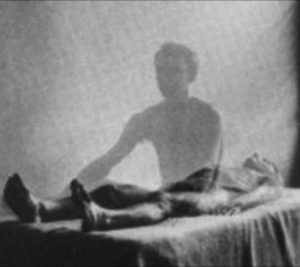 “In the year of 1908, when I [as Nai Leng] was 45 years old, and had already had 3 children, Nang Rien was in the 7th month of her pregnancy. It was the 8th month of that year. I, Nai Leng, had already been sick on and off for several months. During that period of time, this brother and sister [Nai Leng and Nang Rien] recurrently saw each other in their dreams. On Nang Rien’s part, ever since conception, she had an extraordinarily passionate faith in Buddhism, especially with regard to meditation….Indeed, she even wanted to become a bhikkhuni [a nun]. So, on the eve of Buddhist Lent of that year, still being pregnant of course, she left her mother and husband for a monastery…
“In the year of 1908, when I [as Nai Leng] was 45 years old, and had already had 3 children, Nang Rien was in the 7th month of her pregnancy. It was the 8th month of that year. I, Nai Leng, had already been sick on and off for several months. During that period of time, this brother and sister [Nai Leng and Nang Rien] recurrently saw each other in their dreams. On Nang Rien’s part, ever since conception, she had an extraordinarily passionate faith in Buddhism, especially with regard to meditation….Indeed, she even wanted to become a bhikkhuni [a nun]. So, on the eve of Buddhist Lent of that year, still being pregnant of course, she left her mother and husband for a monastery…
While Nang Rien was at the wat praying and meditating, I, Nai Leng was lying sick at home. However, I felt as if I was well aware of Nang Rien’s activities at the wat… All the while that Nang Rien was praying and meditating, I not only knew it, but I saw it.
As it appeared to me, I was always …approximately 2 meters behind her. I never did talk to her…. My eyes never seemed to blink at all. I was merely staring at her, so constantly that I forgot to take notice of my own state of being, that is, how I was able to move along with her… Even while she was praying before the Buddha’s image, I was still looking at her from behind. Then she lit the main pair of candles and three joss sticks [incense sticks]… After having lit all the candles, she started to pray again…Then she would put her hands down, close her eyes, and continue praying until all the joss sticks and candles were burned away…”
Nai Leng Delivers her Son, Choate-Nai Leng Reincarnated
“All along, I knew and saw her activities. But, on the day of her return [from the wat to Ban Kratom], I felt somewhat confused and could not remember anything…I then were recalled that I was sick. One day, there were 4 persons in the house–3 female relatives and Nai Leng’s wife. I opened my eyes and saw and heard what they were saying to each other: ‘At 9 o’clock last night Nan Rien delivered a cute little boy’…I was thinking that if I were normal, I would have gone to visit her also. But here I was, lying sick. All I could do was merely listen to their conversation.
At the moment I felt anguish, and wanted to change from the lying position to a more comfortable one. Seeing that they [the other persons present] were busy talking to each other, I did not ask for their help. Besides, I could not even make my voice heard. Therefore, I tried to turn toward the side wall by myself. I succeeded, but could not retain my balance in that position. So once again, I was lying on my back. I told myself to be content for a while with that degree of comfort.” (4)
Nai Leng’s Out of Body Experience, Death & Awareness of of Events while Out of his Body
 “Thinking that I might be better off if I went to sleep, I then sighed deeply a few times and closed my eyes. At this very moment, I felt as if I was back to normal again. I felt stronger and could move much more rapidly from place to place. My body was light, as if it had no weight. I was so glad that I rushed up to join the conversation of my relatives. But no one noticed me. I grabbed this one’s hand and pulled that one’s arm, to draw their attention. Still, no one did anything.
“Thinking that I might be better off if I went to sleep, I then sighed deeply a few times and closed my eyes. At this very moment, I felt as if I was back to normal again. I felt stronger and could move much more rapidly from place to place. My body was light, as if it had no weight. I was so glad that I rushed up to join the conversation of my relatives. But no one noticed me. I grabbed this one’s hand and pulled that one’s arm, to draw their attention. Still, no one did anything.
The time came to prepare another meal of the day. My relatives were getting ready to leave. One of them felt Nai Leng’s feet. I was then behind her, trying to seize her hand and shoulder. I yelled out, ‘I am here. I am no longer sick. I have recovered already. Do not be afraid or frightened. Do not panic, I am alright.’ However, I could not make them understand.
They were crying and moaning. Some of them went to tell other relatives and friends in the neighborhood. The latter were now pouring into the house.” (5)
Nai Leng Experiences the Expanded Consciousness of the Soul
“At that moment, I felt if I were omnipresent: I could simultaneously see people coming in from 2 or 3 different directions. Moreover, I could be there to receive them all at the same time. I could also hear their voices as well as see things quite clearly.
Far distant places appeared to be near, because I could move very rapidly from place to place. I could immediately be there to hear or see. There seemed to be no obstacle [to movement or vision] and all.
At the same time I was thinking: ‘I am an appointed head of the hosts; I am great. I am the master of ceremonies who has the final word on all matters. I have so great an authority that none can possibly obstruct or encroach upon it.’ However, I was satisfied with what my relatives have done so far. I was so deeply grateful that I did not feel hunger or thirsty. I was so carried away in this enchanting state of emotion that I forgot to sleep and to eat. Nor did I ever feel tired.” (6)
After Death Nai Leng Attends his Own Funeral
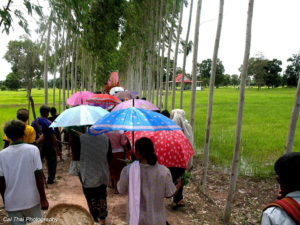 “During the whole of the funeral ceremony (I learned later that it was 3 days), I felt somewhat elevated–by about the height of an average person–above the others. In other words, if others sat, I felt I was standing; if they were standing or walking, I felt as if I were standing or walking on something the level of which was higher than theirs. While the funeral procession was on its way to the cremation, I was sitting in the cart’s curve, the highest part of the cart. That cart, to be sure, did not have a curve; it was merely my feeling that I was at that level. [This refers to a curved frame that could be attached to the cart to hold in materials, such as sacks of rice that were that were being carried in it, but that would be removed during the transport of a body in a coffin.]
“During the whole of the funeral ceremony (I learned later that it was 3 days), I felt somewhat elevated–by about the height of an average person–above the others. In other words, if others sat, I felt I was standing; if they were standing or walking, I felt as if I were standing or walking on something the level of which was higher than theirs. While the funeral procession was on its way to the cremation, I was sitting in the cart’s curve, the highest part of the cart. That cart, to be sure, did not have a curve; it was merely my feeling that I was at that level. [This refers to a curved frame that could be attached to the cart to hold in materials, such as sacks of rice that were that were being carried in it, but that would be removed during the transport of a body in a coffin.]
After the cremation, my relatives gathered the remains. They then invited monks for the ‘remains ceremony,’ which was the last phase of the funeral. It was about 8 o’clock in the evening when the monks finished chanting. My preoccupation with the reception of the guests was somewhat reduced by then. The women who came to help went up to sleep in the house, while the men slept in a disorderly group in a building constructed especially for the ceremony.
On the porch of this building, 3 elderly men was sitting around the stove. They were either chewing Thai gum or smoking cigarettes. They might be considered night watchman of a sort. All of a sudden, a thought of Nang Rien flashed into my mind. ‘I heard that she had just given birth to a child. I have not yet paid her a visit, because I was so busy receiving guests. Now I’m free to go.’” (7)
Nai Leng visits Nang Rein, Who Sees Him as a Ghost
“At the time, I was at the place where the monks were sitting in the wat where the cremation was held. With the said in mind, I turned in the direction of Nang Rien’s house, which was of approximately 200 meters away to the west. No sooner had I decided to move than I was there.
The child, as my relatives had said, was really cute and adorable. I thought to myself: How can I possibly have a chance to touch him and to give him my heartfelt kiss? Nang Rien was then sleeping with her right hand over the child. Before long, she opened her eyes, saw me, and said: ‘My dear brother, you have already departed for another world. Please go to that place which will offer you happiness. Please do not make any more appearances to your brothers and sisters, nor feel concerned about them.’
This was the only time that people ever noticed me and talked to me. I felt so awkward that I went and hid. I was leaning on the wall in front of her room, facing north.” (8)
Reincarnation: Nai Leng Enters Choate’s Infant Body
“After a while, thinking that she was again asleep, I came out to get another glimpse of the child. She again opened her eyes and said the same thing to me. I went back to hide. I told myself that the time had come for me to decide once and for all. I was torn between two feelings. Although I would like to stay, yet I should go; indeed I must go. Before leaving, however, I wish to get another good look at the child. This time I dared not approach lest she reproach me once more. Thus, I poked only my head out. After obtaining a good look, I started to go away again.
As soon as I turned, my body began spinning like a top. I could not regain my balance. I tried to cover my head, face and ears with my hands before I fell unconscious. At that point I thought I was dead.
I did not know how long it was before I regained consciousness. I was wondering where I was. Concentration and recollection told me that not long before this I was Nai Leng. I felt myself full of vigor. Recalling all of the past, I wondered why I was in such a helpless condition. I felt somewhat frustrated.” (9)
As an Infant, Choate Recognizes his Past Life Relatives
 “Later on, I was very glad I could turn to lie on my stomach. Even more so when I could recognize everyone who came to see me. I remembered their names. I waved my hands and tried to call them. However, only guttural sounds, normal to babies, came out. Someone noticed my gesturing and held me up. I was very glad and I laughed heartily. During this period, there were more reward joyful moments then sorrowful ones.”
“Later on, I was very glad I could turn to lie on my stomach. Even more so when I could recognize everyone who came to see me. I remembered their names. I waved my hands and tried to call them. However, only guttural sounds, normal to babies, came out. Someone noticed my gesturing and held me up. I was very glad and I laughed heartily. During this period, there were more reward joyful moments then sorrowful ones.”
Choate Learns to Talk and Calls his Past Life Relatives by Name
“Then came another period during which I learned to walk and talk. One day when my grandmother came, instead of calling her that, I used the word mother. I was governed by past acquaintance in my own memory.” (11)
The grandmother, Ma Chama, was surprised that Choate called her mother and asked: “Well, what is your name then?”
Choate then responded, “’It is Leng.” In his autobiography, Choate continues: “I wondered why they could not recognize me. I was Nai Leng right then and there.” (12)
“Suddenly, Nang Rien exclaimed: ‘No wonder. I saw brother Leng sometimes during the postpartum period. He must have been reborn.’ She then asked: ‘If so, son, what is your name again? What about your wife’s? Where did you live?’ And so on and so forth. I gave correct answers to all questions. They give all concluded that Nai Leng had been reborn.” (13)
Let us review the passage of these events. Choate was born on October 12, 1908. When he learned to speak, though his mother explained who his aunts and uncles were, he still insisted to refer to his uncles and aunts as his brothers and sisters, as if he was still Nai Leng. Similarly, he called his grandmother, Ma Chama, “mother.” She was actually Nai Leng’s mother.
Nai Leng’s Daughters come to believe that Choate is the Reincarnation of their Father
Nai Leng’s daughter, Pa, was 24 years old when he died. When Choate was 4 years old, he recognized her and said, “I am your father” and he called her by her baby nickname. At first Choate’s statements annoyed Pa, but as time went on, she became convinced that Choate was her father reborn.
Poh, Nai Leng’s second daughter, said that as a boy Choate had referred to incidents in her father’s life that Choate could not have known. She said that Choate as a child recognized persons known by her father on sight and called them by their names.
Pi, Nai Leng’s third daughter, recalled that Choate became angry when Nai Leng’s daughters, that is, Pa, Poh and Pi, would not refer to him as “father.”
Nai Leng’s sister, Nem, said that Choate recognized her by name as soon as he could speak. As a child, Choate also recognized Nai Leng’s wife and called her by name and he also correctly named other people Nai Leng had known. (14)
Like a Dalai Lama, Choate identifies his Past Life Possessions
As a child, Choate could correctly separate items belonging to Nai Leng from items that belonged to others. This ability to identify past life possessions is traditionally used by Buddhist monks to identify the reincarnation of a Dalia Lama. (15)
Choate has a Past Life Memory of a Woman who gave Birth on a Road
 As a teenager, Choate spontaneously recalled the event that occurred when Nai Leng was 15 years old, in which Nai Leng encountered the woman who had given birth on a road. Choate’s mother, Nang Rien, who was with Nai Leng when this occurred, confirmed the incident. In Choate’s autobiography, he describes the memory.
As a teenager, Choate spontaneously recalled the event that occurred when Nai Leng was 15 years old, in which Nai Leng encountered the woman who had given birth on a road. Choate’s mother, Nang Rien, who was with Nai Leng when this occurred, confirmed the incident. In Choate’s autobiography, he describes the memory.
“I was Nai Leng at the age of 15. It was an evening at the beginning of the planting season. After finishing the day’s work, my sister, Nang Rien, and I walked home as usual. On our way back, we came across a woman who was resting after having just delivered a child on the road.
The husband was a native of Ban Nua, but his wife came from Ban Tai. His wife had want very much to deliver her child and her mother’s place. As the time for her delivery approached, she insistently asked her husband to take her there. Her husband finally agreed, but not until she was almost due to deliver her baby. By the time the cart reached the place in question, her labor had started. Her husband stopped the cart, untied the oxen and prepared a place for his wife to rest. This was something I’d never seen before. It was strange to me, and as a consequence, it deeply impressed me.” (16)
Though Choate had this memory from his past incarnation as Nai Leng, he did not have comprehension of where this birth occurred. One day, he was tending to cattle that he had taken to feed in pastures. At a particular location, he had a Déjà vu experience. He realized that he was at the spot where the woman gave birth to the child on the road, that he witnessed during his life as Nai Leng. Choate narrates the next scene.
Choate experiences Déjà Vu and Geographic Memory
“As soon as I arrived home that evening, I asked my mother whether any woman had delivered a baby at that place. She said: ‘Yes, but that happened when I was 14 years old and was returning from the field with my 15-year-old brother.’ The brother was I, who had become the youngest son of the sister.” (17)
I term the stimulation of past life memories by a past life location: Geographic Memory
Xenoglossy: Choate Spontaneously is able to Understand Khmer
 At age 16, Choate became a Buddhist monk and entered a monastery, repeating the pattern of Nai Leng’s life. This monastery had Buddhist scriptures written in the Khmer, or Cambodian, language. Choate noticed monks reading these Khmer texts and though he was only schooled in the Thai language, he took some of the Khmer manuscripts to his room to see if he could decipher them. Recall that the Khmer alphabet characters are very different from those of the Thai language.
At age 16, Choate became a Buddhist monk and entered a monastery, repeating the pattern of Nai Leng’s life. This monastery had Buddhist scriptures written in the Khmer, or Cambodian, language. Choate noticed monks reading these Khmer texts and though he was only schooled in the Thai language, he took some of the Khmer manuscripts to his room to see if he could decipher them. Recall that the Khmer alphabet characters are very different from those of the Thai language.
Choate found that he could not read the Khmer manuscripts at first, but on his third attempt, he could understand them without difficulty. In his autobiography, Choate describes this experience.
“The book [written Khmer] had 10 leaves. I went through it within an hour or so. Being afraid that the first reading might not be correct, I began all over again. This reading also took me about an hour. I was not quite satisfied yet, so I read it for the third time. I was very glad as well as surprised that I could read it without having any lessons before. A lot of people have put great effort into it year in and year out, yet only a few succeeded. Later on, I began to write as well as read Khmer… From then on I could read any canonical work, be it in Thai or Khmer. The reason is simple: I was already quite well-versed in it since I had been a monk as Leng. To be sure, part of it was forgotten, but this is only natural.” (18)
This ability to understand a language that has not been learned is called: Xenoglossy
Xenoglossy: Choate Spontaneously is able to Understand Laotian
Another incident that involves xenoglossy occurred. When he was a 19-year-old monk, Choate noticed that villagers around the monastery were speaking Laotian. Choate approached these villagers and found that he could converse with them fluently, even though he was not taught Laotian. For this ability, Choate drew on his past life knowledge of Loatian, which had been learned by Nai Leng. (19)
Choate becomes an Abbot or Head of a Monastery
As Choate grew older, his memories of his life as Nai Leng did not fade, which he attributed to his dedication to the practice of meditation over the course of two lifetimes. Choate died in 1976 at 68 years of age as one of the most respected monks and abbots of Thailand.
Principles of Reincarnation & Understanding Past Lives
Xenoglossy: This case demonstrates what Ian Stevenson, MD termed responsive xenoglossy, where an individual can converse in a language that has not been learned by normal means. In contrast, Stevenson termed the ability to recite or speak an unlearned language without the ability to respond or converse in that language “recitative xenoglossy.”
In this case, Choate, who was only taught the Thai language, was able to converse with individuals from Laos in the Laotian language. In addtion, Choate was able to read Buddhist scriptures written in the Cambodian or Khmer language, even though he never was taught or Khmer. These two languages were learned by Nai Leng and Choate drew upon this past life ability to understand Laotian and Khmer.
Split Incarnation: Choate was born on October 12, 1908, while Nai Leng died the next day on October 13, 1908, which means the soul of Nai Leng animated the bodies of the Nai Leng and the infant Choate at the same time for a period of about a day.
Relationships Renewed through Reincarnation: This case shows that people can reincarnate within the same family, as Nai Leng reincarnated and was born to his own sister, Nai Rien.
 Experience of Death & Spirit Being Involvement: Nai Leng experienced remote viewing in observing Nai Rien while she was at the temple. He also consciously experienced his death and the expanded consciousness of the soul. He attended his own funeral and followed his body as it was being taken to the temple for cremation and he attended the reception after the funeral where he observed his relatives who had gathered for the reception. Nai Leng also was conscious of his rebirth as Choate and what it feels like to be a helpless infant.
Experience of Death & Spirit Being Involvement: Nai Leng experienced remote viewing in observing Nai Rien while she was at the temple. He also consciously experienced his death and the expanded consciousness of the soul. He attended his own funeral and followed his body as it was being taken to the temple for cremation and he attended the reception after the funeral where he observed his relatives who had gathered for the reception. Nai Leng also was conscious of his rebirth as Choate and what it feels like to be a helpless infant.
Note to Readers: Ian Stevenson. MD was a Professor of Psychiatry at the University of Virginia who wrote in a very academic style, as his target audience was fellow scientists. On the IISIS web site, his past life identity cases are presented as children’s past life-reincarnation stories to make his academic work easier to understand. For those interested in appreciating the scientific rigor of his research, such as his use of multiple witnesses to establish corroborated testimony, please refer to the original reports written by Dr. Ian Stevenson.
Footnotes
1. Stevenson, Ian: Cases of the Reincarnation Type, Volume IV, Twelve Cases in Thailand and Burma, University Press of Virginia, Charlottesville, 1983, pages 171-174
2. ibid, pages 174-175
3. ibid, p. 174
4. ibid, pages 174-176
5. ibid, pages 175-176
6. ibid, p. 176
7. ibid, pages 176-177
8. ibid, p. 177
9. ibid, p. 177
10. ibid, pages 177-178
11. ibid, p. 178
12. ibid, p. 178
13. ibid, p. 178
14. ibid, pages 184-185
15. ibid, p. 177
16. ibid, pages 180-181
17. ibid, pages 181-182
18. ibid, pages 183-184
19. ibid, p. 184